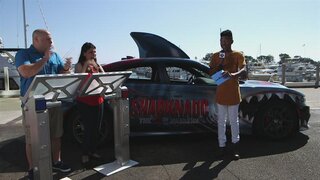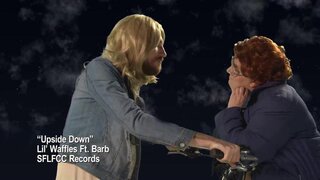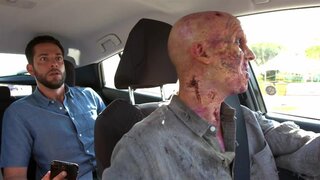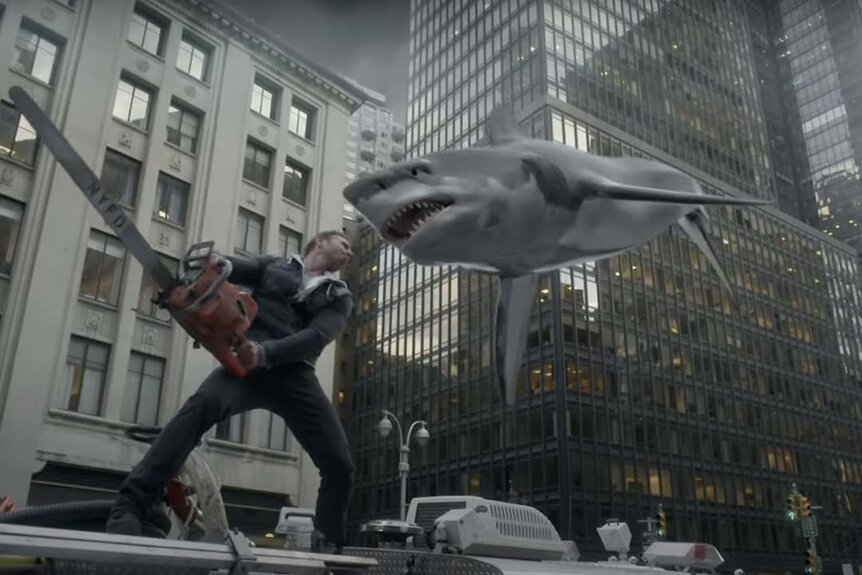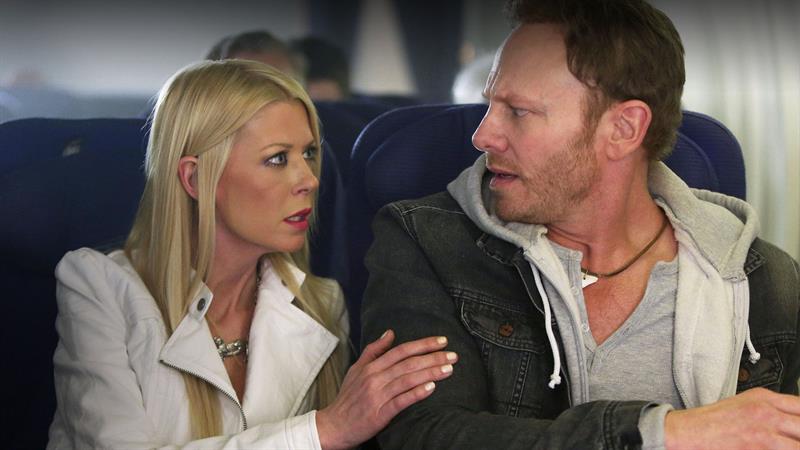Create a free profile to get unlimited access to exclusive videos, sweepstakes, and more!
Sharknado Creators Reflect on Franchise's Impact 10 Years Later: "Sharknado Had That Magic"
“When something goes viral, there's a magic to it, and Sharknado had that magic.”
Everyone check the weather report on SYFY. Sharks, sharks and more sharks — plus winds up to 244 mph as the network honors Sharknado’s 10-year anniversary with a marathon of the saga set to air on July 17.
For "SYFY’s Super Bowl," as director Anthony C. Ferrante called it, SYFY WIRE got the chance to catch up with the minds that brought it all to life: Ferrante, producer Thomas P. Vitale, chief operating officer of the Asylum Paul Bales, and Asylum co-founder David Michael Latt. Indie film studio The Asylum created the original Sharknado with a budget of just $2 million and turned it into a cultural sensation. So, what makes it so special and how did it make such a splash?
How the Sharknado Hype Began
If you’ve somehow missed surfing in the high tide of the Sharknado movies, we’re sure you’ve at least heard of them. In case you haven’t, the gist of the first movie is pretty self-explanatory: a shark infested tornado, a… sharknado is wreaking havoc on Los Angeles as our fearless heroes Fin Shepherd (Ian Ziering), Nova Clarke (Cassie Scerbo) and April Wexler (Tara Reid) try to stop it. It’s not trying to answer philosophical questions, rather it’s an entertaining escapist movie, and does a great job of it. One of the most memorable scenes features Fin jumping through a shark and cutting his way out with a chainsaw. Enough said!
RELATED: The 8 best shark attack movies, ranked
Even with such a bonkers concept, you never know if it’s going to take off. As Vitale put it, “When something goes viral, there's a magic to it, and Sharknado had that magic.” The first movie immediately blew up on Twitter in a cultural moment and the creators all had stories of where they were when it happened. Ferrante told us Chris Connelly, an editor of the first and third movies, called him up and said he heard girls talking about Sharknado in a 7-Eleven. Ferrante didn’t believe him at first. People talking about a TV movie premiere in a 7-Eleven? No way. But yes way. Bales admitted to us, “we’d all be lying if we said that we expected that reaction to this film. No one had any idea.” So, what got all of us to bite?
“The bottom line is that celebrities started tweeting about this ridiculous movie, and that’s what made it successful,” Bales answered. Ferrante agreed celebrities were a big part but added, “fans found us as well, which carried us from the first movie to the sixth movie. We don’t exist without those fans from the very beginning.”
It had the right publicity, but the movie needed teeth to sustain popularity. Luckily, sharks have plenty of them and it started with the cast. “The performances all came together so wonderfully between Ian, Tara, Cassie, and John Heard,” Vitale praised. You never know what you’re going to get, but when you’re making an escapist movie with such an awesomely silly concept, the characters need to believe the situation. “Even if the audience doesn't buy there could be a sharknado, the characters have to live in the reality of the world taking the situation seriously. They need to get in there and they need to want to survive. They need to want to figure out the solution to the sharknado,” Vitale continued. The fun is watching these actors play a ridiculous situation straight up.
RELATED: Freakier than ‘Sharknado’? These mutant sharks thrive on underwater volcanic heat and acid
Sharknado wasn’t the first movie or franchise to prove people like escapist movies, but it was the first to prove they can be a cultural moment of this magnitude. Vitale argues this proof of concept “laid the foundation for a movie like Cocaine Bear to be as successful as it currently is.” And Cocaine Bear was successful, grossing over $89 million featuring a bear shredding through the Georgian forest high on cocaine (stream it now on Peacock). The bear does a line of cocaine off a human leg. It’s funny, it’s campy, it’s ridiculous, it’s awesome. It owes a lot to Sharknado for that.
How Sharknado Became a Film Franchise
With so much success after the first movie, “every celebrity wanted to get in on it. It was just incredible,” Vitale said. This was a great addition to the franchise. Seeing Daymond John act out getting crushed by the Statue of Liberty head? Now that’s peak cinema. When we asked what the creators’ favorite celebrity death was, Bales jokes, “How do you pick your favorite death of a celebrity? Because they’re all so good when they die.” The creators though, especially had praise for Robert Hays who played the pilot in Airplane and reprises his role as a pilot in Sharknado 2: The Second One. Ferrante figured, “that’s when the audience definitely got that we were in on the joke.”
Not everyone understood that after the first movie, as Ferrante said he’s “never seen so many angry journalists complaining sharks can't live in a tornado, blah blah. They were so angry that this was not plausible, and I would always say, yeah, and cars don't turn into robots. Why is this such a disconnect?” Ferrante purposely chose to keep how the sharknados form a mystery, because it would take some of the magic away. This way, “they can live in the air, take down airplanes and live in space because they're sharknado sharks.”
We got to see the space sharks in Sharknado 3: Oh Hell No!, which featured Latt’s favorite shark death when April gave birth inside the shark. You can’t make this stuff up, except Asylum’s team totally did.
You can’t forget about the special effects team that made this all happen, as well. Ferrante applauded them saying, “most studio movies taking on what we took on have two years from start to finish, and we would start shooting these things in March, and then we would be airing in July or August, so the visual effects team would kill themselves every year. That beautiful work. In the sixth movie in particular I think we have over a thousand visual effects shots and they had like six weeks to do it.”
RELATED: How Ian Ziering aced the Zombie Tidal Wave pitch with three simple words
The creators agreed there was a can-do rather than can’t-do attitude throughout the movies, which is part of the culture at the Asylum. This was showcased in Sharknado when they shot the scene of Fin rescuing April from her house as it fills up with shark infested water. They were lost on how to film it but had the idea of building the set in a swimming pool only for the art department to stop building it the night before. They still had to shoot the scene that day, so they did their best and “you couldn’t shoot from certain angles.” The scene of course came out great and when Bales came down to check on it he said, “building a set inside an empty swimming pool outside? Now this is Hollywood magic.”
It feels like all the currents went the right way for these movies. Even the theme song, written by Ferrante and his band Quint (which fun fact changed their name for every other film franchise they made a song for), is catchier than a hooked fish. Bales joked it doesn’t make the Asylum any money, but we think you should give it a listen on Spotify anyways.
With so much to love, Latt concluded his favorite part was, “Finishing. It was such a challenge in every aspect.” The hard work certainly paid off, as Ferrante humbly said, “I thank God you guys hired me to do this, but I was the rare filmmaker, and I started the franchise and I got to kill it.” Latt concluded, “we just hope everybody enjoys the 10th anniversary of Sharknado as much as we've enjoyed bringing it to everybody, and we hope it's an even bigger hit the second time around.”
Be sure to join the moment when we air the Sharknado marathon July 17 on SYFY.
